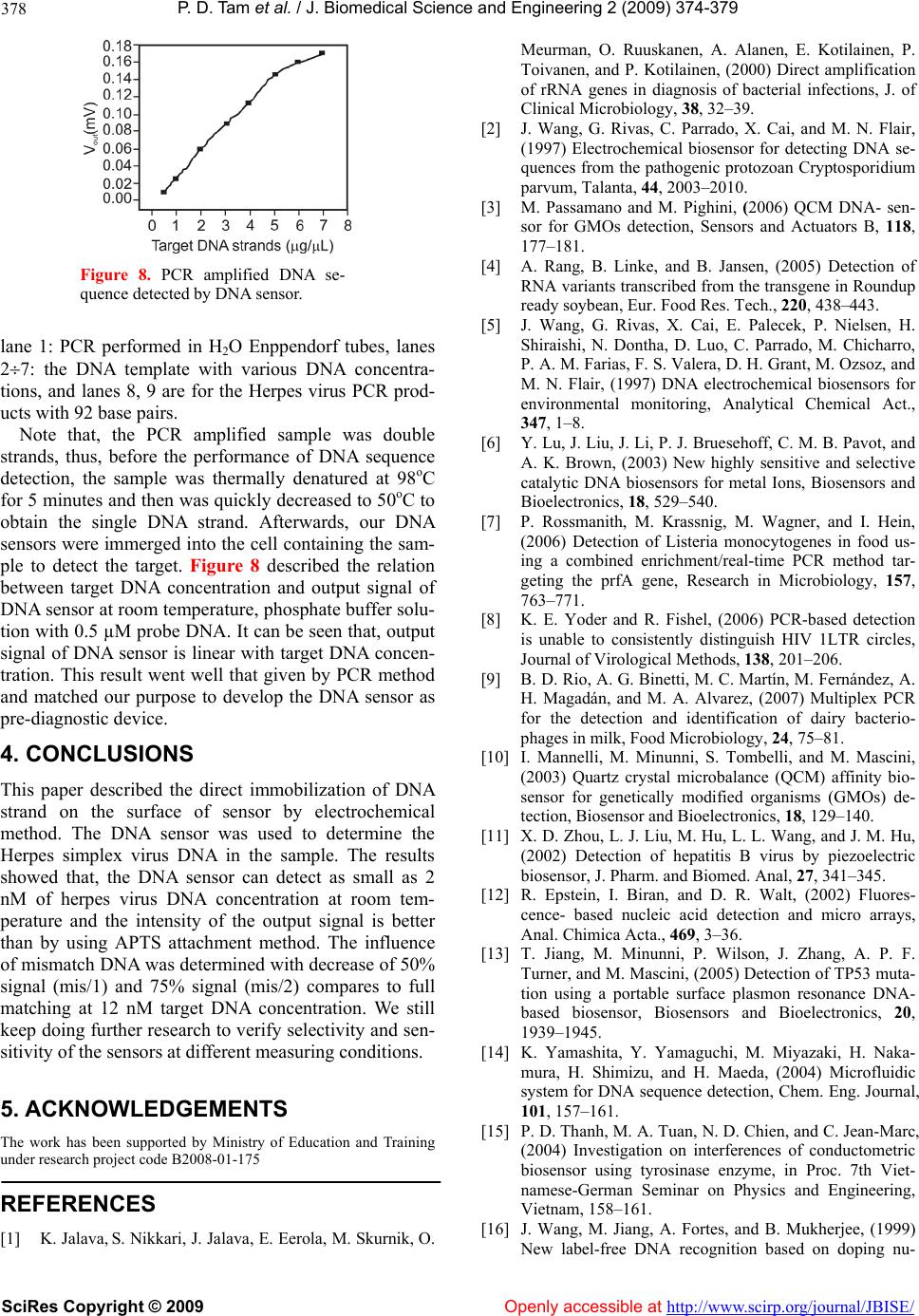
P. D. Tam et al. / J. Biomedical Science and Engineerin g 2 (2009) 374-379
SciRes Copyright © 2009 Openly accessible at http://www.scirp.org/journal/JBISE/
378
Figure 8. PCR amplified DNA se-
quence detected by DNA sensor.
lane 1: PCR performed in H2O Enppendorf tubes, lanes
27: the DNA template with various DNA concentra-
tions, and lanes 8, 9 are for the Herpes virus PCR prod-
ucts with 92 base pairs.
Note that, the PCR amplified sample was double
strands, thus, before the performance of DNA sequence
detection, the sample was thermally denatured at 98oC
for 5 minutes and then was quickly decreased to 50oC to
obtain the single DNA strand. Afterwards, our DNA
sensors were immerged into the cell containing the sam-
ple to detect the target. Figure 8 described the relation
between target DNA concentration and output signal of
DNA sensor at room temperature, phosphate buffer solu-
tion with 0.5 µM probe DNA. It can be seen that, output
signal of DNA sensor is linear with target DNA concen-
tration. This result went well that given by PCR method
and matched our purpose to develop the DNA sensor as
pre-diagnostic device.
4. CONCLUSIONS
This paper described the direct immobilization of DNA
strand on the surface of sensor by electrochemical
method. The DNA sensor was used to determine the
Herpes simplex virus DNA in the sample. The results
showed that, the DNA sensor can detect as small as 2
nM of herpes virus DNA concentration at room tem-
perature and the intensity of the output signal is better
than by using APTS attachment method. The influence
of mismatch DNA was determined with decrease of 50%
signal (mis/1) and 75% signal (mis/2) compares to full
matching at 12 nM target DNA concentration. We still
keep doing further research to verify selectivity and sen-
sitivity of the sensors at different measuring conditions.
5. ACKNOWLEDGEMENTS
The work has been supported by Ministry of Education and Training
under research project code B2008-01-175
REFERENCES
[1] K. Jalava, S. Nikkari, J. Jalava, E. Eerola, M. Skurnik, O.
Meurman, O. Ruuskanen, A. Alanen, E. Kotilainen, P.
Toivanen, and P. Kotilainen, (2000) Direct amplification
of rRNA genes in diagnosis of bacterial infections, J. of
Clinical Microbiology, 38, 32–39.
[2] J. Wang, G. Rivas, C. Parrado, X. Cai, and M. N. Flair,
(1997) Electrochemical biosensor for detecting DNA se-
quences from the pathogenic protozoan Cryptosporidium
parvum, Talanta, 44, 2003–2010.
[3] M. Passamano and M. Pighini, (2006) QCM DNA- sen-
sor for GMOs detection, Sensors and Actuators B, 118,
177–181.
[4] A. Rang, B. Linke, and B. Jansen, (2005) Detection of
RNA variants transcribed from the transgene in Roundup
ready soybean, Eur. Food Res. Tech., 220, 438–443.
[5] J. Wang, G. Rivas, X. Cai, E. Palecek, P. Nielsen, H.
Shiraishi, N. Dontha, D. Luo, C. Parrado, M. Chicharro,
P. A. M. Farias, F. S. Valera, D. H. Grant, M. Ozsoz, and
M. N. Flair, (1997) DNA electrochemical biosensors for
environmental monitoring, Analytical Chemical Act.,
347, 1–8.
[6] Y. Lu, J. Liu, J. Li, P. J. Bruesehoff, C. M. B. Pavot, and
A. K. Brown, (2003) New highly sensitive and selective
catalytic DNA biosensors for metal Ions, Biosensors and
Bioelectronics, 18, 529–540.
[7] P. Rossmanith, M. Krassnig, M. Wagner, and I. Hein,
(2006) Detection of Listeria monocytogenes in food us-
ing a combined enrichment/real-time PCR method tar-
geting the prfA gene, Research in Microbiology, 157,
763–771.
[8] K. E. Yoder and R. Fishel, (2006) PCR-based detection
is unable to consistently distinguish HIV 1LTR circles,
Journal of Virological Methods, 138, 201–206.
[9] B. D. Rio, A. G. Binetti, M. C. Martín, M. Fernández, A.
H. Magadán, and M. A. Alvarez, (2007) Multiplex PCR
for the detection and identification of dairy bacterio-
phages in milk, Food Microbiology, 24, 75–81.
[10] I. Mannelli, M. Minunni, S. Tombelli, and M. Mascini,
(2003) Quartz crystal microbalance (QCM) affinity bio-
sensor for genetically modified organisms (GMOs) de-
tection, Biosensor and Bioelectronics, 18, 129–140.
[11] X. D. Zhou, L. J. Liu, M. Hu, L. L. Wang, and J. M. Hu,
(2002) Detection of hepatitis B virus by piezoelectric
biosensor, J. Pharm. and Biomed. Anal, 27, 341–345.
[12] R. Epstein, I. Biran, and D. R. Walt, (2002) Fluores-
cence- based nucleic acid detection and micro arrays,
Anal. Chimica Acta., 469, 3–36.
[13] T. Jiang, M. Minunni, P. Wilson, J. Zhang, A. P. F.
Turner, and M. Mascini, (2005) Detection of TP53 muta-
tion using a portable surface plasmon resonance DNA-
based biosensor, Biosensors and Bioelectronics, 20,
1939–1945.
[14] K. Yamashita, Y. Yamaguchi, M. Miyazaki, H. Naka-
mura, H. Shimizu, and H. Maeda, (2004) Microfluidic
system for DNA sequence detection, Chem. Eng. Journal,
101, 157–161.
[15] P. D. Thanh, M. A. Tuan, N. D. Chien, and C. Jean-Marc,
(2004) Investigation on interferences of conductometric
biosensor using tyrosinase enzyme, in Proc. 7th Viet-
namese-German Seminar on Physics and Engineering,
Vietnam, 158–161.
[16] J. Wang, M. Jiang, A. Fortes, and B. Mukherjee, (1999)
New label-free DNA recognition based on doping nu-